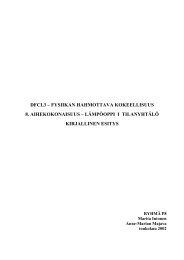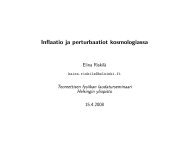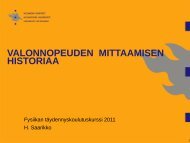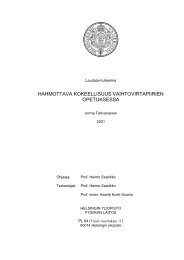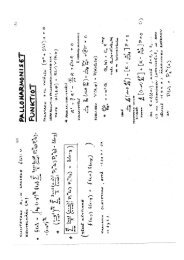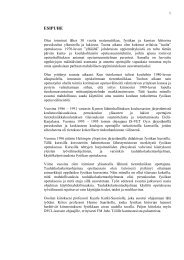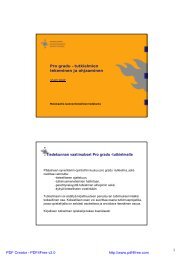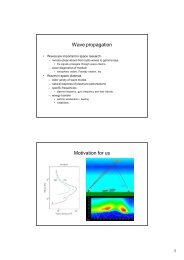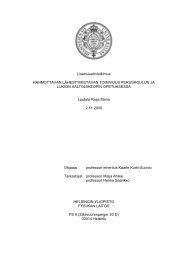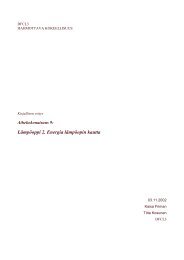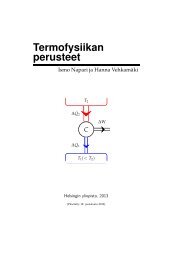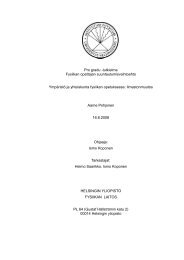Cosmological Perturbation Theory, 26.4.2011 version
Cosmological Perturbation Theory, 26.4.2011 version
Cosmological Perturbation Theory, 26.4.2011 version
You also want an ePaper? Increase the reach of your titles
YUMPU automatically turns print PDFs into web optimized ePapers that Google loves.
6 PERTURBATIONS IN FOURIER SPACE 12The important thing about this division is that the scalar, vector, and tensor parts do notcouple to each other (in first-order perturbation theory), but they evolve independently. Thisallows us to treat them separately: We can study, e.g., scalar perturbations as if the vectorand tensor perturbations were absent. The total evolution of the full perturbation is just alinear superposition of the independent evolution of the scalar, vector, and tensor part of theperturbation.We imposed one constraint on each of the 3-vectors BiV and E i , and 3 + 1 = 4 constraintson the symmetric 3-d tensor Eij T leaving each of them 2 independent components. Thus the10 degrees of freedom corresponding to the 10 components of the metric perturbation h µν aredivided into1 + 1 + 1 + 1 = 4 scalar2 + 2 = 4 vector2 = 2 tensor (5.17)degrees of freedom.The scalar perturbations are the most important. They couple to density and pressure perturbationsand exhibit gravitational instability: overdense regions grow more overdense. Theyare responsible for the formation of structure in the universe from small initial perturbations.Vector perturbations couple to rotational velocity perturbations in the cosmic fluid. Theytend to decay in an expanding universe, and are therefore probably not important in cosmology.We have done all of the above in a fixed gauge. It turns out that gauge transformationsaffect scalar and vector perturbations, but tensor perturbations are gauge-invariant. Tensorperturbations are nothing but gravitational waves, this time 11 in an expanding universe. Whenthey are extracted from the total perturbation by the above separation procedure, they areautomatically in the “transverse traceless gauge”. (This expression is clarified in the nextsection.) Tensor perturbations have cosmological importance since, if strong enough, they havean observable effect on the anisotropy of the cosmic microwave background.6 <strong>Perturbation</strong>s in Fourier SpaceBecause our background space is flat we can Fourier expand the perturbations. For an arbitraryperturbation f = f(η,x i ) = f(η,⃗x), we writef(η,⃗x) = ∑ ⃗ kf ⃗k (η)e i⃗ k·⃗x . (6.1)(Using a Fourier sum implies using a fiducial box with some volume V . At the end of the day wecan let V → ∞, and replace remaining Fourier sums with integrals.) In first-order perturbationtheory each Fourier component evolves independently. We can thus just study the evolution ofa single Fourier component, with some arbitrary wave vector ⃗ k, and we drop the subscript ⃗kfrom the Fourier amplitudes.Since ⃗x = (x 1 ,x 2 ,x 3 ) is a comoving coordinate, ⃗ k is a comoving wave vector. The comoving(or coordinate) wave number k ≡ | ⃗ k| and wavelength λ = 2π/k are related to the physicalwavelength and wave number of the Fourier mode byk phys = 2πλ phys= 2πaλ = a−1 k . (6.2)11 Contrasted to perturbation theory around Minkowski space, which is the way gravitational waves are usuallyintroduced in GR.



